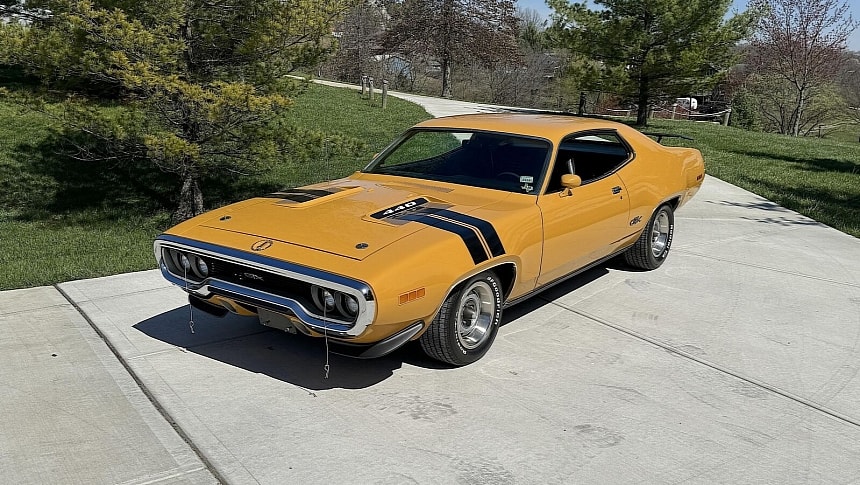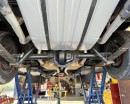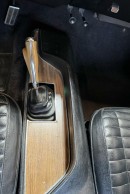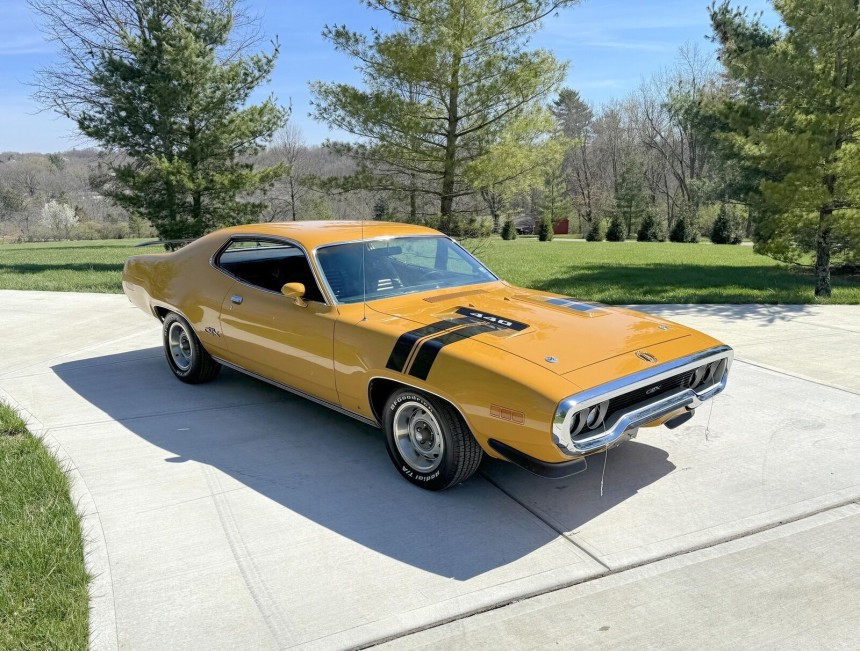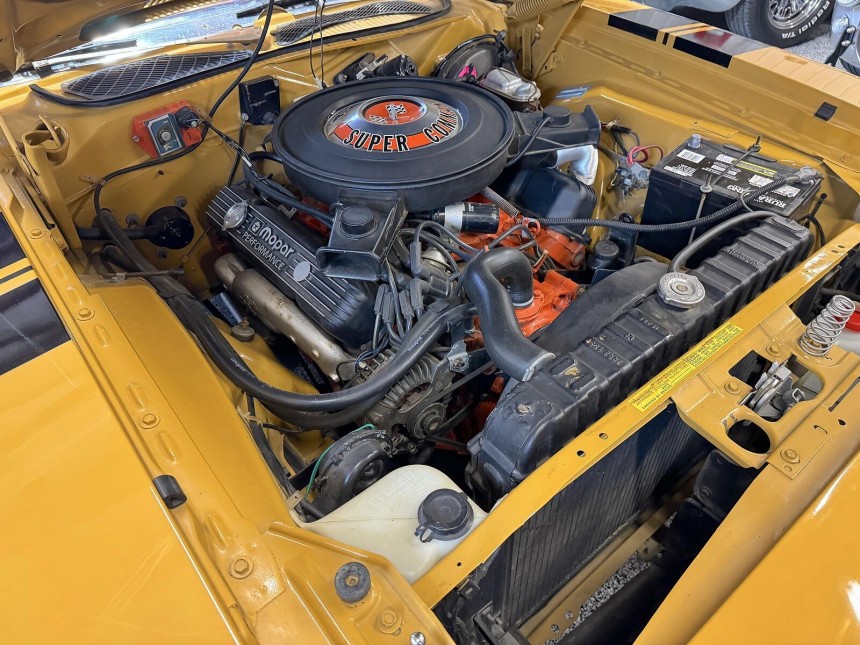In 1967, Plymouth put a new twist on the Belvedere (itself a twist on the Satellite) and named it GTX. 1968, the trim was promoted to model ranks and endured until 1971. Following the muscle car movement's vilification, the GTX was relegated to trim level, this time on the Road Runner. Never a sales champion, the GTX still left an unmistakable mark on the performance history books.
In 1971, the axe fell hard for the first time, dismembering iconic names and chopping down the tire-smoking habits of gearheads. It was the last call for the Street HEMI; in an eerie coincidence, Chrysler removed the GTX from its lineup, settling for a high-end option for the more popular Road Runner. The gentlemen’s muscle car production numbers for that year weren’t particularly encouraging – competition was fierce, both within the Mopar clan and outside.
Less than 3,000 GTXs were assembled for the final model year of the nameplate, which might also have played a decisive role in the cancelation after only five years. Since the GTX’s birth, only two engines were available: the nefarious Street HEMI was the alternative to the standard 440 big-inch behemoth.
Despite its aura of mythological proportions, the 426 cubic-inch HEMI (7.0 liters) was not the go-to choice of the GTX clientele. After all, the bigger V8, the 7.2-liter RB plant, was a substantial performer for much less money than its hemispherical-heads cousin. Hence, out of the 2,942 cars built for 1971, 2,910 were fitted with the biggest Chrysler engines.
Fortunately, the option for the carburetion was still in the books, and a GTX 440 could be ordered with the regular four-barrel single carb or upgraded to the triple twin-barrel setup (for extra cash). Again, the go-fast offering wasn’t very appealing, with only 135 examples rolling off the factory gates as 440 Six-Barrels.
This leaves the 440-4 installment as the mainstay of the 1971 Plymouth GTX – all 2,538 of them. Thought the segregation was over? Think again – there’s still the transmission at stake. Strangely, most of the last true GTXs came with three-speed TorqueFlite automatics, and only 327 buyers went for the all-fun, no-nonsense three-pedal, four-speed manual.
What more could a buyer ask from Mother Mopar for the upscale Plymouth? Well, a set of rear gears to put that engine and gearbox to good use. The Track Pak option offered a Dana 60 with a 3.54 ratio, while the Super Track Pak upped the ante with a 4.10 dragstrip-ready diff. No matter how we look at the numbers, any 1971 Plymouth GTX is rare. However, just as half a century ago, they aren’t in particularly high demand nowadays, either.
The chances of finding an original example are needle-in-a-haystack level statistics, but a clean, correct, documented, well-maintained example could make a nice addition to the chronic piston addiction of a Mopar fan. Take the example in the gallery as a yardstick – a California-built and kept GTX with a U-Code 440-4 V8, a four-speed, and the 3.54 Track Pak.
According to the seller, the sheet metal and numerous interior bits are all original. Still, the heart of the Plymouth, its powertrain, is only date-correct. Maybe that’s one reason for the $59,000 high bid (reserve unmet): the low miles on the odometer - 14,923 / 24,011 km – would require a higher premium.
The seller doesn’t say anything about the car’s past – the obvious question is where the original V8 is and its matching-numbers A833 gearbox. The Dana 60 in the back is the same one the factory put on the car, and so is the pistol grip Hurst shifter. The car is allegedly a solid driver with a straight body (see it in the gallery). The 440-4 still packs a hefty grunt with its 370 hp, 480 lb-ft – 305 hp, 400 lb-ft SAE net. That’s 375 PS, 651 Nm gross, or 309 PS, 542 Nm ‘as-installed’ output numbers.
Less than 3,000 GTXs were assembled for the final model year of the nameplate, which might also have played a decisive role in the cancelation after only five years. Since the GTX’s birth, only two engines were available: the nefarious Street HEMI was the alternative to the standard 440 big-inch behemoth.
Despite its aura of mythological proportions, the 426 cubic-inch HEMI (7.0 liters) was not the go-to choice of the GTX clientele. After all, the bigger V8, the 7.2-liter RB plant, was a substantial performer for much less money than its hemispherical-heads cousin. Hence, out of the 2,942 cars built for 1971, 2,910 were fitted with the biggest Chrysler engines.
This leaves the 440-4 installment as the mainstay of the 1971 Plymouth GTX – all 2,538 of them. Thought the segregation was over? Think again – there’s still the transmission at stake. Strangely, most of the last true GTXs came with three-speed TorqueFlite automatics, and only 327 buyers went for the all-fun, no-nonsense three-pedal, four-speed manual.
What more could a buyer ask from Mother Mopar for the upscale Plymouth? Well, a set of rear gears to put that engine and gearbox to good use. The Track Pak option offered a Dana 60 with a 3.54 ratio, while the Super Track Pak upped the ante with a 4.10 dragstrip-ready diff. No matter how we look at the numbers, any 1971 Plymouth GTX is rare. However, just as half a century ago, they aren’t in particularly high demand nowadays, either.
According to the seller, the sheet metal and numerous interior bits are all original. Still, the heart of the Plymouth, its powertrain, is only date-correct. Maybe that’s one reason for the $59,000 high bid (reserve unmet): the low miles on the odometer - 14,923 / 24,011 km – would require a higher premium.
The seller doesn’t say anything about the car’s past – the obvious question is where the original V8 is and its matching-numbers A833 gearbox. The Dana 60 in the back is the same one the factory put on the car, and so is the pistol grip Hurst shifter. The car is allegedly a solid driver with a straight body (see it in the gallery). The 440-4 still packs a hefty grunt with its 370 hp, 480 lb-ft – 305 hp, 400 lb-ft SAE net. That’s 375 PS, 651 Nm gross, or 309 PS, 542 Nm ‘as-installed’ output numbers.
